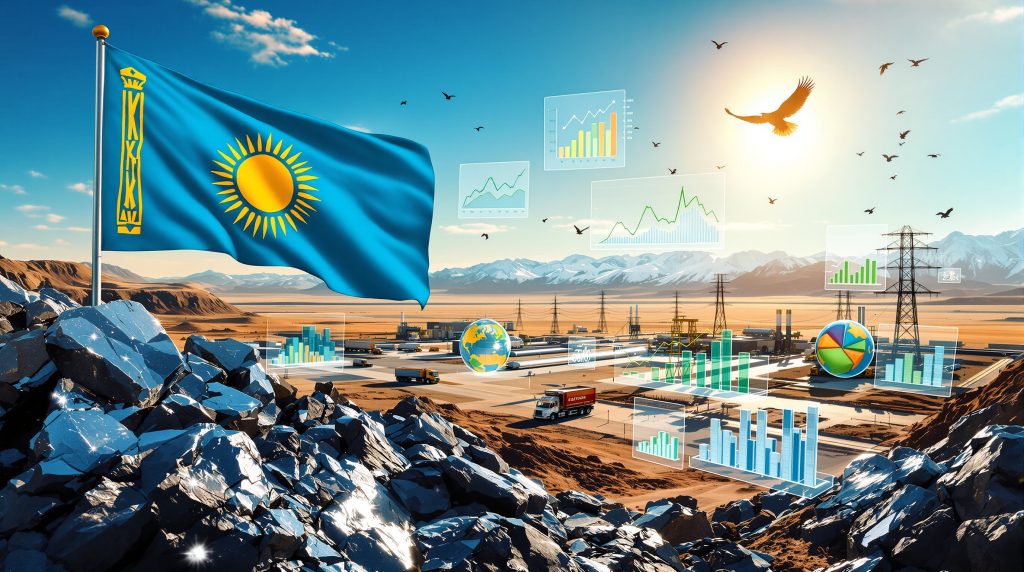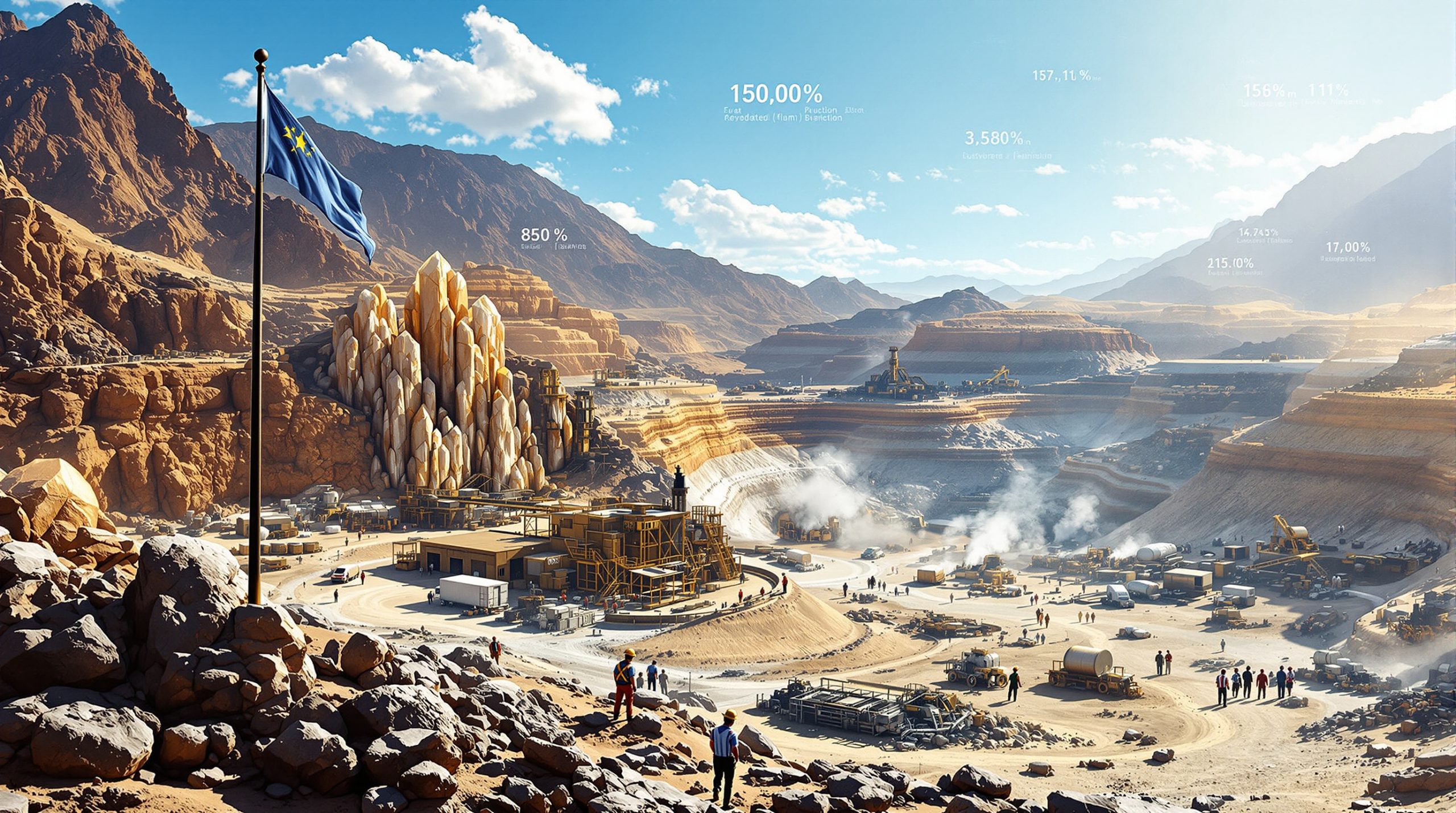Kazakhstan's Emerging Position in Global Vanadium Supply
Kazakhstan is quietly establishing itself as a significant player in the global vanadium market, leveraging unique geographical and geological advantages that set it apart from traditional mining jurisdictions. The country's strategic location between Europe and Asia positions it as a critical link in the global supply chain, while its vast mineral resources offer compelling opportunities for international investors seeking exposure to this essential industrial metal. Furthermore, the critical minerals energy transition demonstrates Kazakhstan's emerging importance in securing future supply chains.
Strategic Geographic Advantages for Mining Operations
Southern Kazakhstan presents distinctly favourable operating conditions compared to the extreme weather challenges faced in northern and eastern regions of the country. While northern Kazakhstan experiences harsh winters with temperatures plunging to minus 40 degrees Celsius, southern regions maintain more manageable conditions, typically reaching only minus 25 degrees during the coldest months. This 70-kilometre proximity to Shymkent, a major transportation hub, provides direct access to established road and rail networks connecting Russian and Baltic markets through to China's eastern coast.
The existing infrastructure development significantly reduces capital requirements for new mining operations. Power infrastructure is already well-established, with 110kV transmission lines serving the region, while roads constructed by Kazatomprom provide immediate access to mining sites. This infrastructure foundation represents millions of dollars in pre-existing investment that benefits new entrants to the market.
Government Support for Critical Minerals Development
Kazakhstan's inclusion of vanadium within its strategic minerals framework reflects the government's recognition of the metal's critical importance to global supply chains. This designation opens pathways for foreign mining companies to access investment incentives and streamlined regulatory processes designed to attract international capital and expertise.
The regulatory environment supports large-scale extraction projects through established mining codes that have been tested by major international operations. Companies like Kazatomprom have demonstrated successful navigation of the regulatory landscape, providing confidence for new vanadium project Kazakhstan developments entering the jurisdiction.
What Makes Kazakhstan's Vanadium Deposits Unique?
Kazakhstan's vanadium deposits represent a departure from conventional extraction methods, offering processing advantages that translate directly into cost savings and environmental benefits. These characteristics stem from the unique geological formation of the ore bodies, which formed over 500 million years ago as ancient seabeds.
Geological Characteristics Setting Projects Apart
The sedimentary black shale formations hosting Kazakhstan's vanadium deposits differ fundamentally from the magnetite deposits that supply 95% of global vanadium production. These formations exhibit remarkable consistency across extensive ore bodies, with grades remaining stable due to their original formation as flat seabeds extending hundreds of kilometres in all directions. Additionally, global mining landscape insights highlight how Kazakhstan's unique deposits position the country competitively.
Key geological advantages include:
• Natural outcropping eliminating pre-stripping requirements
• Syncline cross-sections ideal for open-pit mining operations
• Consistent grade distribution throughout multiple ore bodies
• Maximum pit depths of approximately 150 metres
• Stripping ratios of 4.4:1, significantly lower than many conventional operations
The U-shaped cross-sectional profile of these deposits creates optimal conditions for open-pit extraction, with ore bodies extending kilometres in length while maintaining widths of 100-200 metres. This geometry minimises waste rock handling while maximising ore recovery efficiency.
Processing Advantages Over Traditional Vanadium Sources
The elimination of energy-intensive processing steps represents the most significant advantage of Kazakhstan's black shale deposits. Traditional vanadium extraction from magnetite requires high-temperature roasting processes exceeding 1,000 degrees Celsius, consuming substantial energy and generating significant carbon emissions.
Kazakhstan's deposits enable direct atmospheric and autoclave leaching without concentration or roasting requirements. This process simplification reduces:
• Energy consumption by 40-60% compared to conventional methods
• Environmental impact through elimination of high-temperature processing
• Capital requirements for complex concentration facilities
• Operating complexity through streamlined processing circuits
Economic Fundamentals Driving Project Viability
Recent feasibility studies demonstrate the compelling economics of Kazakhstan vanadium projects, with net present values exceeding $749 million for initial phase development. These economics reflect the fundamental cost advantages inherent in the geological and processing characteristics of the deposits. Moreover, the mining industry evolution showcases how such projects benefit from technological advances.
Production Cost Analysis and Competitive Positioning
| Cost Factor | Kazakhstan Projects | Global Average | Competitive Advantage |
|---|---|---|---|
| Processing complexity | Low (no roasting) | High (roasting required) | 40-60% cost reduction |
| Energy requirements | Moderate | Very High | Significant savings |
| Environmental compliance | Standard | Complex | Lower regulatory costs |
| Stripping ratio | 4.4:1 | Variable (often higher) | Reduced waste handling |
Kazakhstan projects demonstrate production costs of $0.36 per pound (net of by-products), positioning them in the bottom decile of global cost curves. This cost advantage stems primarily from the elimination of energy-intensive roasting processes and the ability to generate revenues from multiple by-products.
Internal rates of return reaching 22% provide substantial returns even during extended periods of low vanadium pricing. This financial resilience proves critical given vanadium's notorious price volatility, which has historically ranged from $5.50 to $50 per pound of vanadium pentoxide.
Revenue Diversification Through By-Products
The 8.5% carbon content within Kazakhstan's vanadium ore bodies creates opportunities for substantial by-product revenues that significantly enhance project economics. Carbon black substitute production represents a $20+ billion global market dominated by tyre industry consumption.
Additional by-product opportunities include:
• Uranium recovery for sale to established processors like Kazatomprom
• Molybdenum extraction adding further revenue streams
• Carbon black substitute commanding premium pricing of approximately $500 per tonne
• Environmental carbon credits valued at $70 per tonne with potential for significant increases
Disclaimer: By-product revenue projections are based on current market conditions and technical assessments. Actual revenues may vary based on market demand, processing efficiency, and regulatory changes.
How Do Vanadium Price Cycles Impact Kazakhstan Projects?
Vanadium markets exhibit extreme volatility patterns that distinguish them from most other industrial metals. Understanding these cycles proves essential for evaluating the long-term viability of vanadium project Kazakhstan developments and their ability to generate consistent returns across varying market conditions. For instance, phase 1 economics show strong returns even during challenging market periods.
Understanding Vanadium Market Volatility Patterns
Historical analysis reveals vanadium prices spending extended periods at floor levels around $5.50 per pound, punctuated by dramatic spikes reaching $50 per pound during supply shortages or demand surges. These cycles typically involve:
• Decade-long low price periods testing project survival
• Short-duration high price spikes generating substantial cash flows
• Supply-demand imbalances driving extreme price movements
• Limited substitute materials preventing demand destruction during high prices
Vanadium's unique market characteristic involves extended periods at floor prices ($5.50/lb) punctuated by dramatic spikes to $50/lb, requiring projects to demonstrate profitability across the entire cycle.
Project developers must design operations capable of maintaining profitability during extended low-price periods while capturing maximum value during price spikes. Kazakhstan's low-cost position provides crucial advantages during market downturns.
Long-Term Demand Drivers Supporting Investment
Steel industry consumption continues driving 80-85% of global vanadium demand, with infrastructure development in emerging economies supporting steady growth. Vanadium's role as a micro-alloying element in high-strength low-alloy steels makes it essential for modern construction and manufacturing applications.
Emerging demand drivers include:
• Vanadium redox flow batteries (VRFB) for grid-scale energy storage
• Infrastructure spending in developing markets
• Construction standards requiring higher strength steels
• Energy transition applications in renewable energy storage
VRFB technology offers particular promise for long-duration energy storage applications, with vanadium's unique property of 100% recyclability providing sustainable advantages over competing battery technologies.
Disclaimer: Demand projections are based on current industry analysis and may not account for technological disruptions, economic downturns, or changes in construction standards that could affect vanadium consumption.
Infrastructure Development and Operational Readiness
Kazakhstan's established infrastructure networks provide immediate operational advantages for vanadium projects, reducing development timelines and capital requirements compared to greenfield locations requiring extensive infrastructure investment.
Power and Transportation Networks
Existing power infrastructure includes 110kV transmission lines with sufficient capacity for initial production phases. Connection points located within 2 kilometres of major project sites eliminate the need for extensive transmission line construction, while transformer capacity additions provide scalability for expansion phases.
Transportation access leverages Kazakhstan's position on the transcontinental route connecting European markets through to China's eastern coast. The 70-kilometre metal roadway to Shymkent provides immediate access to both road and rail transportation networks, eliminating the multi-year development timelines typically required for remote mining projects.
Water supply infrastructure incorporates pipeline designs connecting to established bore fields, with feasibility studies confirming adequate supply for processing requirements. This infrastructure foundation represents millions of dollars in pre-existing investment benefiting new mining operations.
Processing Facility Design and Scalability
Phase 1 production targets of 8,500 tonnes of vanadium pentoxide annually provide a manageable scale-up from pilot operations while generating substantial cash flows. Pilot plant operations processing 15,000 tonnes per year have achieved 91% recovery rates, exceeding conservative feasibility study assumptions of 86%. In addition, modern mine planning techniques optimise these production targets.
| Development Phase | Timeline | Capital Requirement | Key Milestones |
|---|---|---|---|
| Front-End Engineering | 12-18 months | $50-80 million | Process optimisation |
| Phase 1 Construction | 24-30 months | $520 million | Initial production |
| Phase 2 Expansion | 36-48 months | $1.5+ billion | Full-scale operation |
Modular plant design enables staged development that reduces financing requirements while allowing process optimisation between phases. Phase 2 expansion potential targets production increases of 3x, bringing total capacity to approximately 34,000 tonnes annually across all development phases.
What Are the Key Investment Considerations?
Investment evaluation for Kazakhstan vanadium projects requires careful consideration of commodity price volatility, technical scale-up risks, and geopolitical factors specific to Central Asian mining operations. These considerations must be balanced against the compelling economic fundamentals and strategic advantages of the deposits.
Capital Requirements and Funding Pathways
Total capital requirements for full development exceed $2 billion across all phases, with initial phase funding needs of approximately $570 million including front-end engineering. The phased development approach reduces initial capital requirements while providing operational cash flows to support expansion phases. Consequently, capital raising strategies become critical for project advancement.
Funding pathways reflect vanadium's designation as a critical metal in Western countries, opening access to government-supported financing programmes. Alternative funding sources include:
• Strategic partnerships with steel manufacturers seeking supply security
• Chinese EPC contractors offering competitive construction pricing and integrated financing
• Western government programmes supporting critical mineral supply chains
• Streaming and royalty companies seeking exposure to battery metal opportunities
Risk Factors and Mitigation Strategies
Commodity price volatility represents the primary risk factor, with vanadium's extreme price cycling requiring operational flexibility and financial resilience. Low production costs provide crucial protection during extended low-price periods, while high-grade deposits ensure maximum cash generation during price spikes.
Technical scale-up challenges from pilot to commercial production are mitigated through extensive pilot plant operations and conservative feasibility study parameters. Processing risks are reduced through the elimination of complex roasting and concentration processes required by conventional vanadium operations.
Geopolitical considerations in Central Asia require evaluation of political stability, currency controls, and export regulations. Kazakhstan's established mining sector and international investment treaties provide framework protections, while diversified export markets reduce dependence on any single destination. Furthermore, recent developments show vanadium project advancement in Kazakhstan continues despite regional challenges.
Disclaimer: Investment in mining projects involves substantial risks including commodity price volatility, technical challenges, regulatory changes, and geopolitical factors. Investors should conduct thorough due diligence and consider professional advice before making investment decisions.
Carbon Black Substitute: The Hidden Value Driver
Carbon black substitute production represents a transformative opportunity for Kazakhstan vanadium projects, leveraging the 8.5% carbon content within ore bodies to capture value from the $20+ billion global carbon black market. This by-product revenue stream significantly enhances project economics while addressing growing environmental concerns within the rubber industry.
Market Opportunity in Rubber Industry Applications
The global carbon black market consumes approximately 13 million tonnes annually, with tyre production accounting for 80% of total demand. Traditional carbon black production involves burning hydrocarbons at high temperatures, generating substantial CO2 emissions and creating opportunities for lower-emission alternatives.
Carbon black substitute pricing reflects technical performance characteristics, with tyre-grade material commanding approximately $500 per tonne based on comparative testing against conventional products. Lower-grade applications for non-tyre uses offer additional market opportunities at reduced pricing levels.
Environmental advantages provide substantial value premiums as European carbon tariffs expand across industrial sectors. Carbon black substitute products exhibit one-tenth the embedded emissions of conventional carbon black, creating potential for:
• Carbon credit revenues of $70 per tonne at current pricing
• Import tariff advantages under evolving carbon border adjustments
• Premium pricing from environmentally conscious manufacturers
• Supply chain risk reduction through domestically produced alternatives
Product Development and Customer Qualification
Extensive testing programmes conducted with rubber industry consultants confirm carbon black substitute performance across critical parameters including tensile strength, compression characteristics, and abrasion resistance. Tyre applications represent the most demanding specifications, with successful qualification enabling use across all rubber applications.
Market entry strategy focuses initially on second-tier manufacturers in regional markets, building production track records before approaching major Western tyre manufacturers. This approach reflects industry conservatism regarding new materials while building customer relationships and technical credibility.
Current development includes 400 kilograms per hour pilot facilities producing customer samples for qualification testing. Chinese customers have completed laboratory testing with positive results, while multiple parties have expressed purchase interest pending commercial production availability.
Product specifications target 10-micron particle size through optimised milling processes, with dry milling techniques eliminating moisture control challenges. Different grades address varying performance requirements:
• CBS1: Premium tyre-grade material from vanadium processing tailings
• CBS2: Lower-grade material from sub-economic vanadium ore with high carbon content
• Custom specifications: Tailored products for specific customer applications
Comparing Kazakhstan Projects to Global Vanadium Operations
Kazakhstan's vanadium projects offer distinct competitive advantages when evaluated against established global operations, particularly in production costs, processing complexity, and market access. These advantages reflect both geological characteristics and strategic positioning within global supply chains.
Production Scale and Cost Competitiveness
| Project Location | Annual Production | Production Cost | Deposit Type |
|---|---|---|---|
| Kazakhstan (Phase 1) | 8,500t V₂O₅ | Bottom decile | Black shale |
| South Africa | 15,000t V₂O₅ | Mid-range | Magnetite |
| China | 25,000t V₂O₅ | Variable | Mixed sources |
| Brazil | 12,000t V₂O₅ | Higher | Magnetite |
Cost positioning in the bottom decile of global production curves provides crucial advantages during extended low-price periods that characterise vanadium markets. This positioning stems from fundamental geological and processing advantages rather than temporary market conditions or currency effects.
Production scale at 8,500 tonnes annually for Phase 1 operations represents a conservative approach that reduces scale-up risks while generating substantial cash flows. Expansion potential to over 34,000 tonnes annually across multiple phases positions projects among globally significant producers.
Strategic Advantages in Supply Chain Positioning
Kazakhstan's geographic position between major consuming regions provides transportation cost advantages and supply chain flexibility unavailable to many competing operations. Direct rail and road access to both European and Asian markets reduces logistics costs while providing market diversification opportunities.
Political stability and established mining sector frameworks reduce regulatory risks compared to emerging mining jurisdictions. International investment treaties and established precedents provide legal protections while transparent regulatory processes enable project development planning.
Infrastructure advantages including power, transportation, and processing support reduce capital requirements and development timelines compared to greenfield locations. These advantages represent substantial cost savings that enhance competitive positioning throughout project lifecycles.
Future Expansion Potential and Long-Term Vision
Kazakhstan vanadium projects demonstrate exceptional long-term growth potential through multiple ore body development and value chain integration opportunities. This expansion pathway provides investors with exposure to substantial resource bases capable of supporting decades of production growth.
Multi-Ore Body Development Strategy
Seven identified ore bodies across project areas offer sequential development opportunities that extend mine life and production capacity well beyond initial phases. Current exploration has focused on Ore Body 1, with drilling completed on three additional bodies awaiting final assay results.
Resource expansion requires approximately $800,000 in additional assaying to complete formal resource estimates across Ore Bodies 2, 3, and 4. X-ray fluorescent testing confirms ore body locations and characteristics consistent with Ore Body 1, supporting conceptual expansion plans.
Staged exploration approach enables capital-efficient resource development while maintaining focus on near-term production objectives. Sequential development reduces technical risks while providing operational cash flows to fund expansion activities.
Mine life estimates exceed 20 years across all identified ore bodies, with potential for additional discoveries through systematic exploration programmes. This longevity provides stable cash flow generation and substantial asset values for long-term investors.
Integration with Global Vanadium Value Chain
Downstream processing opportunities for battery-grade vanadium products offer value addition possibilities as VRFB markets develop. Minor modifications to processing circuits enable production of different vanadium oxides and ferro-vanadium products targeting specific market segments.
Strategic partnerships with steel and battery manufacturers provide supply security while potentially sharing development costs and technical expertise. These relationships offer market access advantages and long-term contract opportunities that stabilise revenue streams.
Technology development for advanced vanadium applications including energy storage and aerospace uses positions projects to benefit from emerging demand growth. Kazakhstan's research institutions and technical capabilities support continued innovation and product development.
Environmental and Social Considerations
Sustainable mining practices and community engagement form essential components of Kazakhstan vanadium project development, addressing stakeholder concerns while ensuring long-term operational success. Environmental advantages of the processing methods provide additional competitive benefits in increasingly ESG-conscious markets.
Sustainable Mining Practices Implementation
Lower environmental impact processing eliminates high-temperature roasting and complex concentration requirements that characterise conventional vanadium operations. This simplification reduces energy consumption and emissions while minimising processing waste streams.
Tailings management follows international standards with $20-30 million investment in lined storage facilities designed to prevent groundwater contamination. Professional design and construction ensure environmental protection while meeting regulatory requirements.
Water conservation systems incorporate recycling and treatment capabilities that minimise freshwater consumption while protecting local water resources. Pipeline infrastructure from bore fields provides sustainable supply while avoiding surface water impacts.
Carbon footprint reduction through by-product carbon black substitute production offsets traditional carbon black manufacturing emissions while generating additional revenues. This circular economy approach demonstrates environmental leadership while enhancing project economics.
Community Engagement and Local Benefits
Employment opportunities in regional Kazakhstan provide economic benefits to local communities while accessing skilled labour pools developed by existing mining operations. Training programmes and technology transfer enhance local capabilities while building stakeholder support.
Infrastructure development including roads, power, and telecommunications benefits regional economic development beyond direct project impacts. These improvements support broader community development while sharing costs across multiple users.
Skills development programmes provide career advancement opportunities for local residents while meeting project labour requirements. Partnerships with educational institutions ensure sustainable workforce development aligned with project needs and community aspirations.
Investment Timeline and Next Steps for Stakeholders
Kazakhstan vanadium projects approach critical development phases that will determine commercialisation timelines and financing requirements. Stakeholders should monitor key milestones that will validate technical assumptions and market positioning while advancing projects toward production.
Near-Term Development Milestones (2025-2026)
Front-end engineering and design completion represents the immediate priority, with 12-18 month timelines and $50-80 million funding requirements. This phase will optimise process parameters and validate capital cost estimates while advancing procurement and construction planning.
Financing arrangements finalisation must accommodate capital requirements exceeding $520 million for Phase 1 construction while maintaining flexibility for expansion phases. Multiple funding pathways remain under evaluation including strategic partnerships, government programmes, and traditional project finance structures.
Construction commencement targets 24-30 month timelines to initial production, with modular design enabling staged implementation that reduces risks while building operational capabilities. EPC contractor selection will balance cost, timing, and technical capabilities.
Regulatory approvals and environmental permits require completion before construction commencement, with established frameworks and precedents supporting efficient processing. Early engagement with regulatory authorities facilitates approval timelines while addressing stakeholder concerns.
Long-Term Value Creation Pathway
Phase 2 expansion timing depends on market conditions, operational experience, and financing availability, with 3x production increases targeting total capacity of approximately 34,000 tonnes annually. Resource confirmation across multiple ore bodies will support expansion planning and market positioning.
Additional ore body development extends mine life and production capacity well beyond initial phases while providing operational flexibility and market responsiveness. Sequential development reduces capital intensity while maximising resource value.
Market leadership potential in global vanadium supply chains positions projects to benefit from growing demand in both traditional steel applications and emerging energy storage markets. Strategic positioning and cost advantages support long-term competitive positioning for vanadium project Kazakhstan developments.
Disclaimer: Timeline projections are based on current planning assumptions and may be affected by financing availability, regulatory approvals, market conditions, and technical factors. Investors should consider these uncertainties when evaluating investment timing and potential returns.
This analysis is for informational purposes only and does not constitute investment advice. Potential investors should conduct independent due diligence and consult qualified professionals before making investment decisions involving mining projects or commodity markets.
Want to Capitalise on Kazakhstan's Vanadium Opportunity?
Discovery Alert's proprietary Discovery IQ model delivers instant notifications on significant ASX mineral discoveries, including emerging opportunities in critical metals like vanadium that could transform portfolios. Explore how major mineral discoveries generate substantial returns by visiting Discovery Alert's dedicated discoveries page, then begin your 30-day free trial today to position yourself ahead of the market for the next breakthrough discovery.




